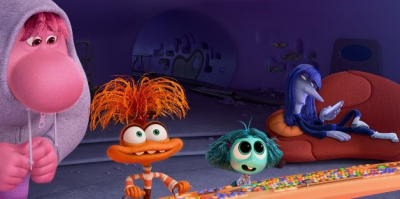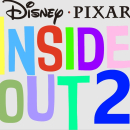Inside Out 2 review
Inside Out 2
When I heard about Inside Out 2 becoming a reality, I couldn't contain my excitement. The first film did a fantastic job of delving into the world of emotions in a deeply emotional yet entertaining way, and I was eager to see what the sequel had in store. So, with anticipation, popcorn in hand, I ventured into the theater, ready to embark on this new journey inside Riley's head.
Visual Grandeur: A Feast for the Eyes
Right off the bat, what struck me was how the visual quality of Inside Out 2 has taken a leap forward. Pixar has truly outdone itself in crafting a world that is not only visually stunning but also rich in detail. From the bright, vibrant colors of the emotions to the more nuanced tones of Riley's evolving personality, every scene felt like a meticulously crafted piece of art. The use of RealD 3D added an extra layer of depth that made the experience even more immersive.
A Symphony of Voices: Stellar Cast Performance
A major highlight for me was the voice acting. Amy Poehler as Joy delivered an uplifting performance that felt both familiar and fresh. Maya Hawke's portrayal of Anxiety was spot-on, capturing the constant jitteriness that characterizes the emotion. Tony Hale and Liza Lapira, taking over the roles of Fear and Disgust, respectively, brought their own unique spin that meshed well with the existing dynamics. The anticipated new voices of Envy, Ennui, and Embarrassment added a fresh layer to Riley's emotional landscape.
Plot Intricacies: A Deep Dive
The plot of Inside Out 2 is ingeniously sophisticated. As Riley navigates the tricky terrain of adolescence and high school, her emotions find themselves joined by new emotions aiming to take control. This premise provided an excellent backdrop for exploring the complexities of a teenager’s emotional state. The way Anxiety, Envy, Embarrassment, Ennui, and Nostalgia are introduced, and conflict with the pre-existing emotions was brilliantly executed.
A New Sense of Self: Complex and Relatable
One of the standout aspects was how the film dealt with Riley's "Sense of Self." This newly formed element of her mind, housing memories and feelings shaping her beliefs felt incredibly realistic. The struggle between Joy trying to maintain positivity and Anxiety focusing on realistic outcomes was a point of personal resonance. It mirrored the real-life conflicts many of us face when balancing optimism and caution.
The Emotions’ Upgraded Console: A Metaphorical Masterpiece
Another metaphorical gem was the upgraded console in Headquarters, symbolizing Riley's cognitive and emotional upgrades during puberty. The ensuing chaos captured how overwhelming this stage of life can be. It created a compelling visual and narrative device that made the intricate changes in Riley’s mind both engaging and comprehensible.
A Deep Dive into Teenage Angst
The film’s portrayal of teenage angst, especially through the character of Anxiety, was particularly strong. Her overbearing presence and compulsive need to control Riley's actions underscored the daily battles faced by teenagers. This portrayal was balanced by Joy, who reminded us that even in the darkest times, moments of happiness and light are worth cherishing.
Moments of Levity: A Dash of Humor
Despite its deep themes, Inside Out 2 didn’t forget to make us laugh. The interactions between the emotions were often hilarious. Embarrassment hiding his face in a hoodie whenever Riley felt ashamed was a recurring gag that never lost its charm. Each new emotion brought with it unique comedic moments that made the film a joy to watch.
Real-World Implications: A Learning Experience
Beyond its entertainment value, the film had real-world implications, offering insights into the psychological aspects of growing up. Consulting psychologists and teenagers ensured that the portrayal of Riley’s emotions and experiences during puberty was accurate and relatable. This not only enriched the film, but also allowed the audience to understand their own emotional landscape more deeply.
Music to the Ears: A Fitting Score
The soundtrack, composed by Andrea Datzman, was another layer that added to the overall emotional gravitas of the film. It captured the essence of each scene perfectly, whether it was the lighthearted moments of Joy taking control or the more somber times of Anxiety's influence. The music flowed seamlessly with the narrative, enhancing the impact of each emotional beat.
Animation Evolution: Details Matter
The advancements in animation were undeniable. The detailed rendering of each emotion, the fluidity of their movements, and the expressive backgrounds all contributed to a more immersive experience. Every frame was packed with meticulous detail that showcased the evolution of animation technology while maintaining the charm of the original film.
A Balance of Old and New: Intergenerational Appeal
One of the remarkable aspects was how the film balanced the introduction of new characters with the presence of familiar ones. This made it appealing to both newcomers and fans of the original film. It struck a chord with various age groups, making it a film that parents could enjoy just as much as their children.
Emotional Complexity: A Universal Theme
The film excelled in conveying the complexity of human emotions. It showed that happiness, sadness, fear, disgust, and anger are all essential parts of our emotional spectrum, and the addition of anxiety, envy, embarrassment, ennui, and nostalgia broadened this spectrum in meaningful ways. It underscored that every emotion has its place and purpose, making the narrative both touching and enlightening.
Relationship Dynamics: Friends and Family
The dynamics of Riley's relationships with her friends and family were beautifully portrayed. The strains and reconciliations added layers to her character and highlighted the importance of social connections during adolescence. These interactions were deftly handled, adding depth to the storyline and making it more relatable.
Lessons in Self-Acceptance
The underlying message of self-acceptance resonated strongly with me. The journey to understanding that it's okay to have a multifaceted identity filled with both positive and negative aspects was empowering. It offered a nuanced take on how we should embrace all parts of ourselves to truly find inner peace and happiness.
Consistent Pace: Engaging Throughout
From start to finish, the film maintained a consistent pace. There were no dull moments or unnecessary filler scenes. Every moment contributed to the progression of the storyline, keeping me engaged and interested in Riley's journey and the evolving dynamics of her emotions.
Conclusion: A Worthy Sequel
All in all, Inside Out 2 was a phenomenal experience that lived up to the legacy of its predecessor while carving out its own identity. It combined stunning visuals, a compelling storyline, and an excellent voice cast to create an engaging and emotionally resonant film. Not only did it entertain, but it also provided valuable insights into the complexities of growing up.
Pros:
- Stunning visual quality;
- Excellent voice acting;
- Compelling and realistic plot;
- Accurate portrayal of teenage emotions;
- Relatable new characters;
- Effective use of metaphors;
- Well-composed musical score;
- Advanced animation details;
- Intergenerational appeal;
- Consistent pacing.
Cons:
- Predictability of some external plot elements;
- New emotions are not as memorable as original ones.


Inside Out 2 review
To download the app, you will get links to the Official Website and/or official digital markets.



















